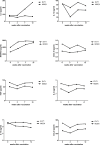Enhanced neutralizing antibody response induced by inactivated enterovirus 71 in cynomolgus monkeys
- PMID: 30278051
- PMCID: PMC6168120
- DOI: 10.1371/journal.pone.0202552
Enhanced neutralizing antibody response induced by inactivated enterovirus 71 in cynomolgus monkeys
Abstract
Enterovirus 71 (EV71) is a major etiological agent of various public health issues, particularly in the Asia-Pacific region. EV71 causes hand-foot-and-mouth disease (HFMD) and is associated with serious neurological disorders in young children. A formalin-inactivated EV71 candidate vaccine (KCDC-HFMDV1-EV71) based on the C4 subgenotype was previously developed and confirmed to be a potential candidate vaccine for prevention of EV71 infection in mice. In this study, an inactivated EV71 vaccine was used for analysis of long-term immunogenicity and efficacy in cynomolgus monkeys, a common nonhuman primate model. The vaccine was immunized three times at 0, 4, and 8 weeks with either 20-μg doses of EV71 candidate vaccine formulated with aluminum hydroxide gel adjuvant or phosphate-buffered saline as a control. The group immunized with the inactivated EV71 showed significantly increased EV71-specific antibody and serum neutralizing antibody titers at 3 weeks after vaccination and maintained these elevated titers until the end of the experiment (54 weeks after vaccination). The sera from vaccinated cynomolgus monkeys showed a crossreactive neutralizing antibody response to the heterologous subtype of EV71 (B1-4, C1, and C2). These findings suggest that the inactivated EV71 candidate vaccine may be a potential vaccine candidate and valuable tool for the control of HFMD.
Conflict of interest statement
The authors have declared that no competing interests exist.
Figures



Similar articles
-
An inactivated hand-foot-and-mouth disease vaccine using the enterovirus 71 (C4a) strain isolated from a Korean patient induces a strong immunogenic response in mice.PLoS One. 2017 May 24;12(5):e0178259. doi: 10.1371/journal.pone.0178259. eCollection 2017. PLoS One. 2017. PMID: 28542556 Free PMC article.
-
Enterovirus type 71 neutralizing antibodies in the serum of macaque monkeys immunized with EV71 virus-like particles.Vaccine. 2012 Feb 8;30(7):1305-12. doi: 10.1016/j.vaccine.2011.12.081. Epub 2011 Dec 31. Vaccine. 2012. PMID: 22214888
-
Evaluation of monovalent and bivalent vaccines against lethal Enterovirus 71 and Coxsackievirus A16 infection in newborn mice.Hum Vaccin Immunother. 2014;10(10):2885-95. doi: 10.4161/hv.29823. Hum Vaccin Immunother. 2014. PMID: 25483672 Free PMC article.
-
Production of EV71 vaccine candidates.Hum Vaccin Immunother. 2012 Dec 1;8(12):1775-83. doi: 10.4161/hv.21739. Epub 2012 Sep 19. Hum Vaccin Immunother. 2012. PMID: 22992566 Free PMC article. Review.
-
Enterovirus 71: a whole virion inactivated enterovirus 71 vaccine.Expert Rev Vaccines. 2016 Jul;15(7):803-13. doi: 10.1080/14760584.2016.1191357. Epub 2016 Jun 6. Expert Rev Vaccines. 2016. PMID: 27206811 Review.
Cited by
-
Development of an Enterovirus 71 Vaccine Efficacy Test Using Human Scavenger Receptor B2 Transgenic Mice.J Virol. 2020 Feb 28;94(6):e01921-19. doi: 10.1128/JVI.01921-19. Print 2020 Feb 28. J Virol. 2020. PMID: 31896594 Free PMC article.
-
Rational design of a DNA-launched live attenuated vaccine against human enterovirus 71.Virol Sin. 2024 Oct;39(5):812-820. doi: 10.1016/j.virs.2024.09.008. Epub 2024 Sep 19. Virol Sin. 2024. PMID: 39306193 Free PMC article.
-
The application and discovery of animal models in enterovirus research.Arch Virol. 2025 Jul 8;170(8):175. doi: 10.1007/s00705-025-06367-6. Arch Virol. 2025. PMID: 40629191 Review.
References
-
- Cardosa MJ, Perera D, Brown BA, Cheon D, Chan HM, Chan KP, et al. Molecular epidemiology of human enterovirus 71 strains and recent outbreaks in the Asia-Pacific region: comparative analysis of the VP1 and VP4 genes. Emerging infectious diseases. 2003;9(4):461–8. Epub 2003/04/19. 10.3201/eid0904.020395 ; PubMed Central PMCID: PMCPMC2957976. - DOI - PMC - PubMed
-
- Yip CC, Lau SK, Zhou B, Zhang MX, Tsoi HW, Chan KH, et al. Emergence of enterovirus 71 "double-recombinant" strains belonging to a novel genotype D originating from southern China: first evidence for combination of intratypic and intertypic recombination events in EV71. Arch Virol. 2010;155(9):1413–24. Epub 2010/06/16. 10.1007/s00705-010-0722-0 . - DOI - PMC - PubMed
-
- Schmidt NJ, Lennette EH, Ho HH. An apparently new enterovirus isolated from patients with disease of the central nervous system. J Infect Dis. 1974;129(3):304–9. Epub 1974/03/01. . - PubMed
Publication types
MeSH terms
Substances
LinkOut - more resources
Full Text Sources
Miscellaneous

